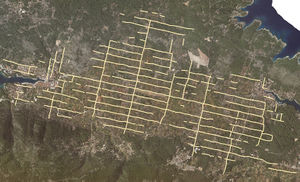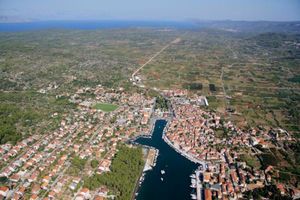Landscape Democracy 2015 Working Group B - Case Study 5: Difference between revisions
No edit summary |
No edit summary |
||
| (One intermediate revision by one other user not shown) | |||
| Line 36: | Line 36: | ||
== Rationale: Why have you chosen this case for the landscape and democracy seminar? == | == Rationale: Why have you chosen this case for the landscape and democracy seminar? == | ||
Stari Grad Plain on the Adriatic island of Hvar is a cultural landscape that has remained practically intact since it was first colonized by Ionian Greeks from Paros in the 4th century BC. The original agricultural activity of this fertile plain, mainly centring on grapes and olives, has been maintained since Greek times to the present. The site is also a natural reserve. The landscape features ancient stone walls and trims, or small stone shelters, and bears testimony to the ancient geometrical system of land division used by the ancient Greeks, the chora which has remained virtually intact over 24 centuries. | Stari Grad Plain on the Adriatic island of Hvar is a cultural landscape that has remained practically intact since it was first colonized by Ionian Greeks from Paros in the 4th century BC. The original agricultural activity of this fertile plain, mainly centring on grapes and olives, has been maintained since Greek times to the present. The site is also a natural reserve. The landscape features ancient stone walls and trims, or small stone shelters, and bears testimony to the ancient geometrical system of land division used by the ancient Greeks, the chora which has remained virtually intact over 24 centuries. | ||
Its land organisation system, based on geometrical parcels with dry stone wall boundaries (chora), is exemplary. This system was completed from the very first by a rainwater recovery system involving the use of tanks and gutters. | |||
The Greek cadastral system has been fully respected during the continuous agricultural use of the plain, based on the same crops. This system is today perfectly identifiable, and has changed very little. Stari Grad Plain forms an agricultural and land use ensemble of great integrity. The authenticity of the Greek land division system known as chora is clearly in evidence throughout the plain. The built structures of the stone walls are authentic, with the same basic dry stone wall materials being used and reused since the foundation by the Greeks. | |||
Stari Grad plain was inscribed on the UNESCO List of World Heritage sites in 2008. | |||
== Representation of your observations == | == Representation of your observations == | ||
| Line 54: | Line 60: | ||
*Please add approx. 150 words for each questions | *Please add approx. 150 words for each questions | ||
== Stakeholder Mapping == | |||
''Create a visual representation of the stakeholder groups that are involved in your case. Try to cover the following aspects in your representation: Power (high, medium, low) / Support (positive, neutral, negative)/ Influence (high or low)/ Need (strong, medium, weak)+ also map the relationships between the stakeholder groups'' | |||
<gallery caption="Stakeholder Map" widths="600px" heights="300px" perrow="1"> | |||
File:mystakeholermap.JPG|Stakeholder Map | |||
</gallery> | |||
== Change Scenario == | |||
''Look at the various methods and tools available and think how they can be applied creatively. Think about the needs of different stakeholder groups - you may need a methodical mix to address them all. Visualize a scenario illustrating how these methods/tools can be applied within an imagined time frame '' | |||
<gallery caption="Change Scenario" widths="600px" heights="300px" perrow="1"> | |||
File:mychange szenario.JPG|Change Scenario | |||
</gallery> | |||
== Cross cutting theme == | |||
Identify a cross-cutting theme/topic between the cases of your group and write a short reflection on it (approx. 150 words) | |||
== Concluding reflections == | |||
Reflect on your case and your change model. Potentials? Limitations? (approx. 150 words) | |||
== References == | == References == | ||
Latest revision as of 12:41, 9 December 2015
---> back to group page working group B
Stari Grad Plain on the island of Hvar
| Place name | Stari Grad Plain | |
| Location | Island of Hvar | |
| Country | Croatia | |
| Author(s) | Ana Žmire | |

| ||

| ||
|
| ||
Rationale: Why have you chosen this case for the landscape and democracy seminar?
Stari Grad Plain on the Adriatic island of Hvar is a cultural landscape that has remained practically intact since it was first colonized by Ionian Greeks from Paros in the 4th century BC. The original agricultural activity of this fertile plain, mainly centring on grapes and olives, has been maintained since Greek times to the present. The site is also a natural reserve. The landscape features ancient stone walls and trims, or small stone shelters, and bears testimony to the ancient geometrical system of land division used by the ancient Greeks, the chora which has remained virtually intact over 24 centuries.
Its land organisation system, based on geometrical parcels with dry stone wall boundaries (chora), is exemplary. This system was completed from the very first by a rainwater recovery system involving the use of tanks and gutters.
The Greek cadastral system has been fully respected during the continuous agricultural use of the plain, based on the same crops. This system is today perfectly identifiable, and has changed very little. Stari Grad Plain forms an agricultural and land use ensemble of great integrity. The authenticity of the Greek land division system known as chora is clearly in evidence throughout the plain. The built structures of the stone walls are authentic, with the same basic dry stone wall materials being used and reused since the foundation by the Greeks.
Stari Grad plain was inscribed on the UNESCO List of World Heritage sites in 2008.
Representation of your observations
- you are basically free to use one or a mix of different presentation techniques
- possibilities are: analytical drawings, graphical representations, collages, video clips, comic/graphic novel, written essay/visual essay
- please add any visual material to the gallery, videos can be placed below, you may add text as you like
- Design Synthesis Drawings
- Yourfilename1.jpg
case representation
- Yourfilename2.jpg
case representation
- Yourfilename3.jpg
case representation
- Yourfilename4.jpg
case representation
Reflection
What are the major challenges for changing the situation?
What could be a starting point for democractically-based change?
- Please add approx. 150 words for each questions
Stakeholder Mapping
Create a visual representation of the stakeholder groups that are involved in your case. Try to cover the following aspects in your representation: Power (high, medium, low) / Support (positive, neutral, negative)/ Influence (high or low)/ Need (strong, medium, weak)+ also map the relationships between the stakeholder groups
- Stakeholder Map
- Mystakeholermap.JPG
Stakeholder Map
Change Scenario
Look at the various methods and tools available and think how they can be applied creatively. Think about the needs of different stakeholder groups - you may need a methodical mix to address them all. Visualize a scenario illustrating how these methods/tools can be applied within an imagined time frame
- Change Scenario
- Mychange szenario.JPG
Change Scenario
Cross cutting theme
Identify a cross-cutting theme/topic between the cases of your group and write a short reflection on it (approx. 150 words)
Concluding reflections
Reflect on your case and your change model. Potentials? Limitations? (approx. 150 words)
References
[1] UNESCO
About categories: You can add more categories with this tag: "", add your categories